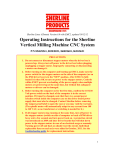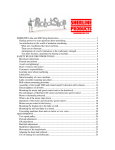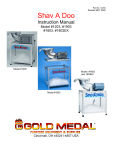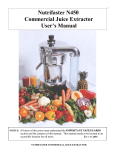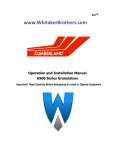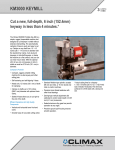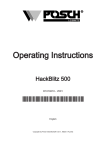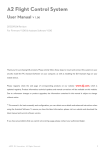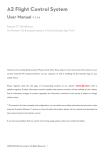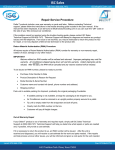Download 2261-inserted tip carbide boring tools
Transcript
CAUTION: HOT CHIPS! The chips produced by carbide insert tools can be very HOT! Remember, your hands are closer to the cutting edge when using miniature machine tools, so use caution. Torx wrench P/N 2259 (80°) 2260 (55°) 2261 (pair 2259 and 2260) WARNING Carbide cutting tips may chip or fragment in use. Always use machine guards, protective clothing and safety glasses to prevent burns or other injury to body or eyes from flying particles or chips. Grinding produces hazardous dust. To avoid adverse health effects, use adequate ventilation and read Material Safety Data Sheet for applicable carbide grade first. For Data Sheet write to: Valenite, 31100 Stephenson Hwy., Madison Heights, MI 48071 Using Carbide Inserted Tools I would first like to emphasize that I believe the prime method of cutting metals on a miniature metal cutting lathe should be high speed steel. It’s inexpensive, easy to sharpen, and can be shaped to make "form" tools. Insert tooling is expensive, can’t be resharpened or shaped, but it can be a lifesaver. The obvious difference between carbide tools and inserted carbide tools is the tip is held on with a screw rather than brazed on to a piece of steel. This fact has a lot to do with the success of insert tools in recent years. Steel and carbide have slightly different expansion rates which can cause premature failure of the carbide tip. It is surprising that a small screw will hold these inserts tight enough to accurately cut metal, but they do. We run 20-horsepower computer controlled lathes at Sherline that can remove metal at a rate of 2 pounds (1 kilogram) a minute with these tools and have few failures. The reasons I believe insert tools should have a place in your shop is they are ready to use, they hold their cutting edge when cutting exotic metals or abrasive materials, and can speed up the cutting process. Normal cutting speed rules don’t have to be considered to the same extent as when using high speed steel. Stainless steel can be cut at triple the rate over high speed steel with these tools. This puts you in a better horsepower range on the Sherline motor. Another interesting fact is you can get a better finish on some steels, such as cold rolled, by turning up the RPM. Insert tools don’t need cutting oils to work well, but I still use a few drops now and then. This can be an important fact when working on your kitchen table. I experimented with various tools before making a choice. I wanted a cutting tool that had a positive rake. I don’t SHERLINE PRODUCTS INCORPORATED 1974 INSERTED TIP CARBIDE BORING TOOLS P/N 2259, 2260, 2261 believe the tools we manufacture are rigid enough for negative rake tools which cost less and are far more popular.* These tools are designed for machines that weigh hundreds of times more than a Sherline lathe. Positive rake tools have to be sharpened at the time of manufacture which adds to their cost, but also adds to their performance on a Sherline machine. You can’t use any insert in these holders unless it has a positive cutting edge. *A negative rake tool holder designed especially for Sherline lathes, P/N 7610, is now available. It is extremely rigid and allows the use of a 55° negative rake carbide tip which, because of the design of the holder, cuts like a positive rake cutter. The tool offers a cost advantage as well. FIGURE 1—Negative and positive rake carbide cutting tips. Negative rake tips can be held upside down giving four cutting edges. Positive rake tips cut from one side only, but cut better. These boring tools have positive rake. Another choice I made was the .015" (4mm) radius on the tip. A large tool radius can give good finishes on a full size machine, but it can cause havoc on small diameter parts or miniature machines. Large radius tools create high tool loads because of their large cutting surface. A radius smaller than .015" will chip too easily. The difference between the 80° and 55° tools is that the 80° tool is a little stronger at the tip, but the 55° tool can get into corners. If you plan to only purchase one, buy the 55°. The 80° tool is a good choice to rough cut with. To get maximum life out of these tools be sure to increase the "feed" as you increase the RPM. The chip should have a tight curl to it and break off into short lengths. These chips can be very HOT. Remember, your hands are closer to the cutting edge when using miniature machine tools, so use caution. Another plus for insert tools is their ability to cut hard or abrasive materials. Don’t plan on machining down the SHERLINE PRODUCTS INC. ˆ 3235 Executive Ridge ˆ Vista ˆ California 92081-8527 ˆ FAX: (760) 727-7857 Toll Free Order Line: (800) 541-0735 ˆ International/Local/Technical Assistance: (760) 727-5857 ˆ Internet: www.sherline.com 4/6/10 shanks on end mills with them, but you can cut through a work hardened surface on stainless steel with ease. These tools can simplify many machining operations, but will never solve problems caused by poor machining practices. As with all machining operations, WEAR EYE PROTECTION. 3/8" Round Boring Tools Sherline offers boring tools with two different tip shapes: The P/N 2259 boring tool accepts an 80° carbide insert and requires a minimum hole size of 1/2". P/N 2260 accepts a 55° carbide insert and requires a minimum hole size of 3/4". In addition to fitting into a smaller hole, the 80° holder offers a little more strength, while the 55° holder will cut into a sharper corner. The total length of the tool is 3-1/4", and with full insertion in the tool post (2 hold-down screws engaged on the flat) you can bore a hole about 2" deep. Further extension is possible but not recommended due to the potential for tool flex. Each tool comes with one carbide insert, a hold-down screw of the appropriate length and a T7 Torx key to tighten the hold-down screw. The holders can be held in the round hole of the P/N 7600 tool post for use on a Sherline lathe. Using a boring bar The use of a boring tool requires the existence of a drilled or cored hole, or it may be used to enlarge the bore of a tube. The work must be mounted in a chuck or on a faceplate and the boring tool set as shown in Figure 2 below. Note the clearance behind the cutting point. CLEARANCE FIGURE 2—A conventional ground steel tool is shown in this illustration, but a carbide tool is used in the same manner for boring. The boring bar is designed with a flat on the top surface. The two hold-down screws of the P/N 7600 tool holder are tightened on this flat to both lock the tool in position and keep it from rotating. Extend the tip of the tool only as far as necessary to bore the depth you need. The farther the tool extends from the holder, the more it can flex. This can cause you to bore a taper, give a poor finish or, in extreme cases, cause the insert to dig in or break. The further the tool is extended, the lighter the cut should be. Sherline used to offer a longer boring bar made by another manufacturer, but we now make this one ourselves and have limited the length to what we feel is safe and appropriate for Sherline tools. If you have a longer bar we do not recommend you extend the tool more than a few inches from the holder to limit tool flex. BORING TIP: When boring inside a hole, chip buildup can be a problem. Stop and clear chips often using a probe or small brush. Do not try to remove them when the part is turning. Some machinists find that working with the tool rotated 180° so the chips come out the bottom side works better for helping them to clear the part by themselves. The disadvantage of this method is that the flat for the hold-down screws is no longer useable and the tool is held less securely. Also, because the tool body is not hardened, take care not to over-tighten the screws when tightening against the round part of the tool. If the metal on the round shaft is upset (dented) by the screw head, it may become difficult to remove the tool from the round hole in the tool post. Speeds and feed rates for boring As is true for all carbide tools, these boring tools favor higher cutting speeds than high speed steel tools. Cutting should be done at the fastest speed you can use without getting tool chatter. We recommend a feed rate of about .002" per revolution (.05 mm/rev). Joe Martin, President and Owner Sherline Products Inc. P/N 22591 22601 7605 7608 76230 76770 PARTS LISTING CARBIDE BORING TOOL HOLDERS DESCRIPTION 80° boring tool holder body 55° boring tool holder body 55° carbide insert (DPMT 21.51 2A VC29) 80° carbide insert (CPMT 21.21 2A VC29) Torx screw T7 Torx driver P/N 2261, Pg. 2 of 2


